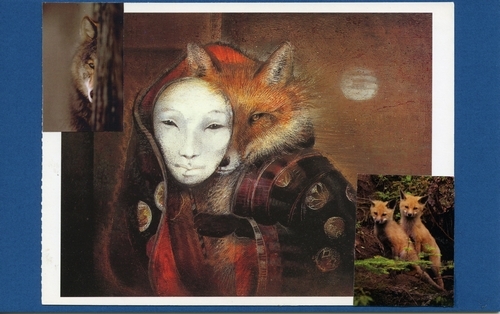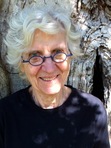THERE IS ANOTHER WAY (SoulCollage)
 Once, in a poem, I wrote “There is another way / to enter an apple. / A worm’s way.” I am finding another way to enter my writing. It allows me to go inside, through a door I didn’t even know was there, have a fresh experience, savor a new and delicious taste, surprise myself.
Once, in a poem, I wrote “There is another way / to enter an apple. / A worm’s way.” I am finding another way to enter my writing. It allows me to go inside, through a door I didn’t even know was there, have a fresh experience, savor a new and delicious taste, surprise myself.
Sometimes something goes “bump” in the mind. A hint, a tease, or an outright “smack upside the head” when you are trying with all your might to get into your writing. It takes practice to learn the difference between the inner chatter of writer’s block, and the gentle nudge of an idea trying to get in. The chatter is just annoying distraction. The nudge is a gift. Some writers call a magical moment of inspiration “the muse.” I like better the way Goethe understood it. He said, “When one is fully committed, Providence moves, too.” Some writers claim they receive dictation from some source beyond themselves. I have never felt that, although frequently I do feel assisted — by “Providence” or whatever — but only when I am in need, fully committed, and paying attention.
Life is crowded. I got up at 4:30 this morning to answer email that had piled up — more than 130 unanswered messages. Then, sleep deprived and groggy, I turned to my necessary writing task – to create a blog entry inviting readers to come to a workshop I will be leading with Sue Reynolds. I got a cup of coffee, curled up on the couch with my computer, and got nothing. Nada! I wanted to say something about the relation between visual and written art. Something about pictures and writing. But what? What?
The first nudge today was an issue of Smithsonian Magazine that had been lying around our living room for a week or more without attracting my attention. Its full page cover photo is of horses painted in a cave in France 30,000 years ago. They were visible to the artist only by firelight, yet the horses seem almost to dance, muscles rippling in the sun. Why did that prehistoric artist also trace around his or her own hand, leaving handprints that we try to “read” 30,000 years later?
Is it possible that visual art is also a language, and writing is also a visual art? As we read, do we not paint pictures on the cave walls of the mind? And was the cave artist not telling stories with his or her horses, his or her hand?
The second nudge came as I was finishing answering email. A friend had sent a passage from Frederick Buechner’s book, Whistling in the Dark, but I had been too busy to read it. He begins with a haiku poem by Basho:
“An old silent pond. / Into the pond a frog jumps. / Splash! Silence again.” It is perhaps the best known of all Japanese haiku. . . . Basho, the poet, makes no comment on what he is describing. He implies no meaning, message, or metaphor. He simply invites our attention to no more and no less than just this: the old pond in its watery stillness, the kerplunk of the frog, the gradual return of the stillness.
In effect he is putting a frame around the moment, and what the frame does is enable us to see not just something about the moment but the moment itself in all its ineffable ordinariness and particularity. The chances are that if we had been passing by when the frog jumped, we wouldn’t have noticed a thing or, noticing it, wouldn’t have given it a second thought. But the frame sets it off from everything else that distracts us. It makes possible a second thought. That is the nature and purpose of frames. The frame does not change the moment, but it changes our way of perceiving the moment. It makes us NOTICE the moment, and that is what Basho wants above all else. It is what literature in general wants above all else too.
From the simplest lyric to the most complex novel and densest drama, literature is asking us to pay attention. Pay attention to the frog. Pay attention to the west wind. Pay attention to the boy on the raft, the lady in the tower, the old man on the train. In sum, pay attention to the world and all that dwells therein and thereby learn at last to pay attention to yourself and all that dwells therein.
The painter does the same thing, of course. Rembrandt puts a frame around an old woman’s face. It is seamed with wrinkles. The upper lip is sunken in, the skin waxy and pale. It is not a remarkable face. You would not look twice at the old woman if you found her sitting across the aisle from you on a bus. But it is a face so remarkably seen that it forces you to see it remarkably just as Cezanne makes you see a bowl of apples or Andrew Wyeth a muslin curtain blowing in at an open window. It is a face unlike any other face in all the world. All the faces in the world are in this one old face.
“Putting a frame around the moment.” “Paying attention.” Buechner suggests that is what all art does – music, painting, writing. All at once I understood what Sue is helping me to do, and what I want to say about it
I have always, ever had only one art form: writing. The damage was done in a fourth grade classroom when a teacher told us to “draw night,” Then she walked up and down the aisles between rows of desks, stopped beside me, took my paper to the front of the classroom, held it up and said in a loud voice, “This is the way NOT to draw night!” Of course I didn’t hear another word. That was seventy years ago. I can still taste the shame on my tongue. And I still don’t know how to “draw night.”
 The SoulCollage card of foxes pictured here is one I made in the workshop we led together last summer. It is about my mother. Her complexity, her beauty, her fearsome wildness. The kits are my brother and myself. In making this “SoulCollage” I was able to express something wilder, stranger, and more beautiful, than I had ever expressed about Mama. Working silently looking for images, I found her, saw her more clearly, and began to write about her with a greater depth of understanding of what she gave me, as well as how she hurt me.
The SoulCollage card of foxes pictured here is one I made in the workshop we led together last summer. It is about my mother. Her complexity, her beauty, her fearsome wildness. The kits are my brother and myself. In making this “SoulCollage” I was able to express something wilder, stranger, and more beautiful, than I had ever expressed about Mama. Working silently looking for images, I found her, saw her more clearly, and began to write about her with a greater depth of understanding of what she gave me, as well as how she hurt me.
Flannery O’Connor, perhaps America’s greatest short story writer, too up drawing, she said, to help her see more clearly the images she was describing in her writing,
Sue is teaching me with SoulCollage another way to enter the apple of my poem. She and I will be cutting, pasting, and writing together in Amherst again in June with a dozen other people – we will write in my old farmhouse near the center of this college town, a short walk from Emily Dickinson’s home and grave. We will make collage cards in the “great hall” of a local Protestant church. We will eat sumptuous meals catered by the Black Sheep Deli. For more information, please go to THIS LINK.



